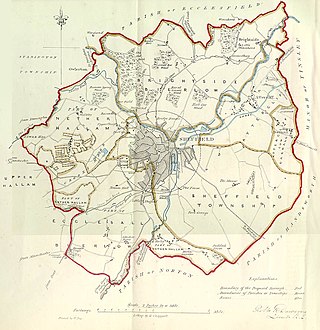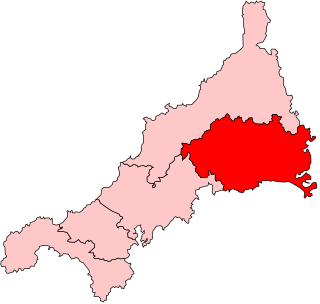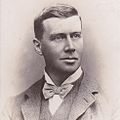
Ashton-under-Lyne is a constituency in Greater Manchester that was created in 1832. It has been represented in the House of Commons of the UK Parliament by Angela Rayner of the Labour Party since 2015. Rayner currently serves as Deputy Prime Minister and Secretary of State for Housing, Communities and Local Government in the cabinet of Keir Starmer, and was elected as Deputy Leader of the Labour Party in 2020.

Sheffield was a borough constituency represented in the House of Commons of the Parliament of the United Kingdom from 1832 to 1885. It elected two Members of Parliament (MPs) by the bloc vote system of elections.
Dumfries Burghs was a district of burghs constituency of the House of Commons of Great Britain from 1708 to 1801 and of the House of Commons of the Parliament of the United Kingdom from 1801 until 1918. It elected one Member of Parliament (MP).
Wick Burghs, sometimes known as Northern Burghs, was a constituency of the House of Commons of the Parliament of the United Kingdom from 1832 to 1918. It elected one Member of Parliament (MP) by the first past the post voting system.
Sunderland was a borough constituency in the House of Commons of the United Kingdom, created by the Reform Act 1832 for the 1832 general election. It elected two Members of Parliament (MPs) by the bloc vote system of election. It was split into the single-member seats of Sunderland North and Sunderland South for the 1950 general election.

Bodmin was the name of a parliamentary constituency in Cornwall from 1295 until 1983. Initially, it was a parliamentary borough, which returned two Members of Parliament to the House of Commons of England and later the House of Commons of the Parliament of the United Kingdom until the 1868 general election, when its representation was reduced to one member.

Westmorland was a constituency covering the county of Westmorland in the North of England, which returned Members of Parliament to the House of Commons of the Parliament of the United Kingdom.
Hythe was a constituency centred on the town of Hythe in Kent. It returned two Members of Parliament to the House of Commons until 1832, when its representation was reduced to one member. The constituency was abolished for the 1950 general election, and replaced with the new Folkestone and Hythe constituency.

Clitheroe was a parliamentary constituency in Lancashire.
Bury was a borough constituency centred on the town of Bury in Lancashire. It returned one Member of Parliament (MP) to the House of Commons of the Parliament of the United Kingdom.
Oldham was a parliamentary constituency centred on the town of Oldham, England. It returned two Members of Parliament (MPs) to the House of Commons of the Parliament of the United Kingdom. The constituency was created by the Great Reform Act of 1832 and was abolished for the 1950 general election when it was split into the Oldham East and Oldham West constituencies.

South Lancashire, formally called the Southern Division of Lancashire or Lancashire Southern, is a former county constituency of the South Lancashire area in England. It returned two Members of Parliament (MPs) to the British House of Commons from 1832 to 1861, and then from a very narrow reform of that year, three until it was further split in 1868.
Manchester was a Parliamentary borough constituency in the county of Lancashire which was represented in the House of Commons of the Parliament of the United Kingdom. Its territory consisted of the city of Manchester.
Bolton was a borough constituency centred on the town of Bolton in the county of Lancashire. It returned two Members of Parliament (MPs) to the House of Commons for the Parliament of the United Kingdom, elected by the bloc vote system.
Southampton was a parliamentary constituency which was represented in the English and after 1707 British House of Commons. Centred on the town of Southampton, it returned two members of parliament (MPs) from 1295 until it was abolished for the 1950 general election.
Appleby was a parliamentary constituency in the county of Westmorland in England. It existed for two separate periods: from 1295 to 1832, and from 1885 to 1918.

West Cumberland was a county constituency in the House of Commons of the Parliament of the United Kingdom. It elected two Members of Parliament (MPs) by the bloc vote system of election.
Stoke-upon-Trent was a parliamentary borough in Staffordshire, which elected two Members of Parliament (MPs) to the House of Commons from 1832 until 1885, and then one member from 1885 until 1918, when the borough was enlarged, renamed Stoke-on-Trent, and split into three single-member constituencies.
Beaumaris was a parliamentary borough in Anglesey, which returned one Member of Parliament (MP) to the House of Commons of the Parliament of England from 1553, then to the Parliament of Great Britain from 1707 to 1800 and to the Parliament of the United Kingdom from 1801 to 1885, when the constituency was abolished. After 1832, the constituency was usually known as the Beaumaris District of Boroughs or simply the Beaumaris Boroughs.

James Cropper was an English Liberal politician who sat in the House of Commons from 1880 to 1885.








